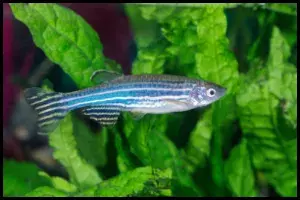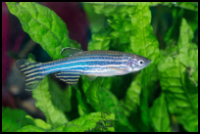
Quick Care Details (Table)
| Livestock Characteristics | Value |
|---|---|
| Care Level | Easy |
| Temperament | Peaceful |
| Diet | Omnivore |
| Maximum Size | 3 Inches |
| Minimum Tank Size | 20 Gallons |
| Plant Safe | Yes |
| Temperature Range | 68-78F |
| PH Range | 6.5-7.5 |
| KH Range | 8-12 |
Species Specific Categories
Helpful Video
Care Details
Aquascape: Zebra Danios prefer a well-aerated aquarium with plenty of swimming space. They enjoy environments with plants and open areas for swimming.
Substrate: They do well with fine gravel or sand substrate. Smooth substrate is preferable to avoid damaging their delicate barbels.
Disease Prevention: Regular water changes and maintaining good water quality are crucial. Quarantine new fish before introducing them to the main tank to prevent diseases.
Filtration: A moderate to strong filtration system is recommended to maintain water quality, as Zebra Danios are active swimmers and can be messy eaters.
Lighting: They don't have specific lighting requirements but prefer a natural day-night cycle. Avoid excessively bright lights to prevent stress.
Water Flow: Moderate water flow is suitable. Ensure the current isn't too strong, especially if keeping them with smaller or less agile tank mates.
Hardiness: Zebra Danios are hardy fish and can tolerate a range of water conditions. They are a good choice for beginner aquarists.
Acclimation: When introducing them to the tank, acclimate them slowly to prevent stress and shock. Float their bag in the tank and gradually add tank water over time.
Expected Lifespan: In well-maintained aquariums, Zebra Danios can live for about 3 to 5 years, sometimes longer with proper care.
Special Requirements: They are schooling fish and should ideally be kept in groups of at least 6. Provide a balanced diet including flake or small pellet food supplemented with occasional live or frozen foods for variety.
Temperament and Behavior
Behavior: Zebra Danios are active and lively fish that enjoy swimming throughout the tank. They often explore their environment and are known for their playful behavior.
Breeding: They are relatively easy to breed in captivity. Provide a separate breeding tank with fine-leaved plants or a breeding mop where they can scatter their eggs.
Aggression: Zebra Danios are peaceful and non-aggressive. They get along well with most other peaceful fish species.
Tankmates Compatibility: They are compatible with other small, peaceful fish such as tetras, rasboras, and peaceful barbs. Avoid keeping them with fin-nipping species or larger aggressive fish.
Activity Level: They are highly active swimmers and will use all levels of the aquarium, from top to bottom.
Schooling or Shoaling Behavior: Zebra Danios are schooling fish and should be kept in groups of at least 6 individuals. In larger groups, they exhibit more natural schooling behavior, which reduces stress and enhances their activity levels.
Plant Compatibility: They are generally compatible with most aquatic plants. Choose robust plants as they may nibble on softer leaves. Plants like Java fern, Anubias, and Vallisneria are good choices.
Diet and Nutrition
Dry Foods: Dry foods such as high-quality flakes or pellets should form the staple of their diet. These foods are formulated to provide essential nutrients and vitamins necessary for their growth and immune system support. Look for brands that list whole fish or fish meal as primary ingredients, as these offer a balanced nutritional profile. Feed them small amounts multiple times a day, ensuring they consume the food quickly to prevent overfeeding and water quality issues.
Frozen Foods: Offering frozen foods like bloodworms, brine shrimp, or daphnia adds variety and nutrition to their diet. These foods are rich in proteins and are especially beneficial as occasional treats or to stimulate breeding behavior. Thaw frozen foods in a small cup of aquarium water before feeding to prevent any temperature shock to the fish.
Live Foods: Live foods such as blackworms, mosquito larvae, or live daphnia are eagerly accepted by Zebra Danios and provide them with a natural hunting experience. These foods are highly nutritious and can be fed occasionally to supplement their diet and promote natural behaviors. Ensure any live foods are from a reputable source to prevent introducing diseases into the aquarium.
Vegetables: Although primarily carnivorous, Zebra Danios may occasionally nibble on blanched vegetables such as zucchini or cucumber slices. These vegetables provide fiber and some essential nutrients. Offer small, thinly sliced pieces that can be easily consumed and remove any uneaten portions promptly to maintain water quality.
Algae: While not a significant part of their diet, Zebra Danios may graze on soft algae that grow naturally in the aquarium. This behavior helps to supplement their diet with vegetable matter and adds variety. However, ensure the tank has sufficient algae growth without becoming excessive, as it can affect water quality.
Feeding Schedule: Establishing a consistent feeding schedule helps maintain the health and behavior of Zebra Danios. Feed them small amounts of food two to three times a day, ensuring they consume all the food within a few minutes. This schedule mimics their natural feeding behavior in the wild, where they would encounter frequent but small meals throughout the day.
Supplemental Foods: Occasionally supplement their diet with specialized foods like spirulina flakes or freeze-dried foods such as tubifex worms. These foods provide additional nutrients and can help enhance their coloration and overall health. Use these supplements sparingly, incorporating them into their diet a few times a week to avoid overfeeding and potential digestive issues.
By offering a diverse range of foods and maintaining a regular feeding schedule, you can ensure that your Zebra Danios thrive and exhibit their natural behaviors in your aquarium setup.
Tank Parameters
- Tank Size: Zebra Danios (Danio rerio) are small fish and can thrive in tanks as small as 10 gallons for a small group. Larger tanks, such as 20 gallons or more, are recommended for larger groups or mixed communities.
- Tank Length and Measurements: A longer tank setup is preferable for Zebra Danios, as they are active swimmers. Aim for tanks with dimensions that provide ample horizontal swimming space, such as 24 inches or more in length.
- Water Temperature: Maintain a stable water temperature between 64-75°F (18-24°C). They can tolerate slight fluctuations but prefer consistent conditions.
- pH (Acidity/Alkalinity): Ideally, keep the pH level between 6.5 to 7.5. They can adapt to a slightly broader range but prefer neutral to slightly acidic conditions.
- KH (Carbonate Hardness): Carbonate hardness should be moderate, around 2-10 dKH (degrees of carbonate hardness), to ensure pH stability and support their health.
- GH (General Hardness): General hardness should be in the range of 5-15 dGH (degrees of general hardness). They can adapt to a range of water hardness levels but prefer slightly harder water.
- Hardiness: Zebra Danios are hardy fish and can adapt to a variety of water conditions, making them suitable for beginner aquarists.
- Nitrate (NO3) Levels: Keep nitrate levels below 20 ppm (parts per million) through regular water changes and proper filtration. Elevated nitrate levels can stress fish and compromise their health over time.
History, Popularity, History and Species Variety Details
The History, Popularity, and Natural Habitat:
History: The Zebra Danio (Danio rerio) has a rich history in the aquarium hobby. Originally native to streams and rice paddies of Eastern India, Bangladesh, Nepal, and Myanmar, it was first introduced to the aquarium trade in the early 20th century. Its hardy nature, vibrant appearance, and active demeanor quickly made it a favorite among aquarists worldwide. Beyond its role as a popular aquarium fish, the Zebra Danio has also been studied extensively in genetics and developmental biology due to its transparent embryos, which allow researchers to observe developmental processes easily.
Popularity: Zebra Danios are widely regarded as one of the most popular and beginner-friendly fish species in the hobby. Their small size, striking striped patterns, and robustness make them ideal for both novice and experienced aquarists. They are often chosen for community tanks due to their peaceful nature and compatibility with a wide range of tank mates. Their active swimming behavior and ease of care contribute to their enduring popularity among aquarium enthusiasts.
Natural Habitat: In their natural habitat, Zebra Danios inhabit clear, slow-moving streams, rivers, and shallow rice paddies with sandy or gravelly bottoms. These environments typically have dense vegetation and subdued lighting. They are adapted to water temperatures ranging from cool to moderately warm, usually between 18-24°C (64-75°F). Zebra Danios are known for their ability to thrive in various water conditions, from slightly acidic to slightly alkaline, and tolerate fluctuating water parameters characteristic of their native habitats during seasonal changes.
Similar and Variations of the Species:
- Leopard Danio (Danio rerio var. frankei): Features a spotted pattern resembling a leopard, rather than stripes.
- GloFish® Zebra Danio (Danio rerio): Genetically modified variety with fluorescent colors, available in various hues including red, green, orange, and purple.
- Longfin Zebra Danio (Danio rerio): Exhibits elongated finnage compared to the standard Zebra Danio, enhancing its visual appeal.
- Golden Zebra Danio (Danio rerio var. frankei): A color variation with golden-yellow hues instead of the typical silver and blue stripes.
Frequently Asked Questions
Do Zebra Danios need plants in their tank?
While not essential, plants provide them with hiding spots and mimic their natural habitat, enhancing their well-being.
How long do Zebra Danios live?
With proper care, they can live for about 3 to 5 years, sometimes longer in optimal conditions.
Do Zebra Danios need a lot of space?
They're active swimmers, so provide a tank with plenty of horizontal swimming room, especially in longer tanks.
Can Zebra Danios live with other fish?
Yes, they're peaceful and get along well with other small, non-aggressive fish like tetras and rasboras.
How many Zebra Danios should I keep together?
They thrive in groups of at least 6 to mimic their natural schooling behavior and reduce stress.


